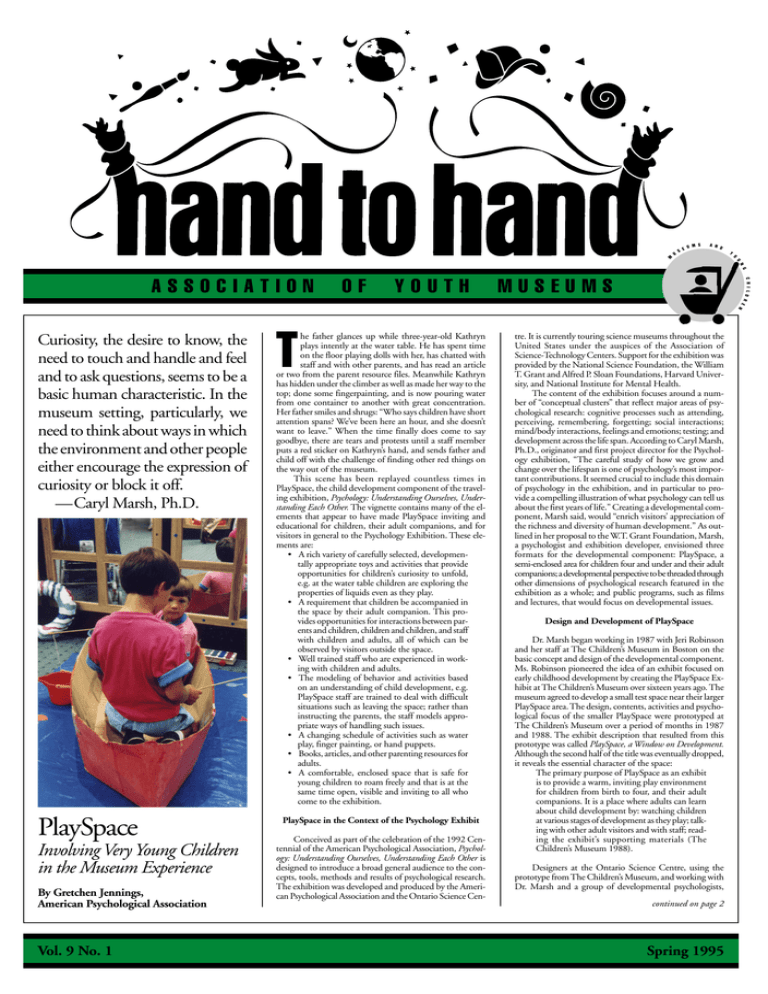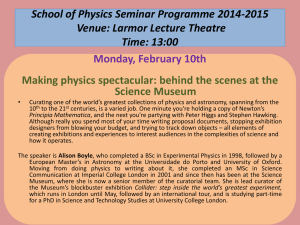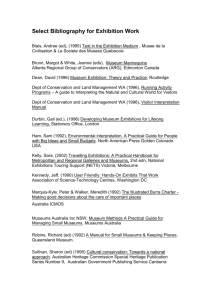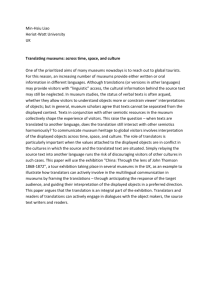
S
M S
E U
A N
D
Y
O
M
U
U
N
G
OF
YOUTH
C H I L D R
E
ASSOCIATION
MUSEUMS
N
Curiosity, the desire to know, the
need to touch and handle and feel
and to ask questions, seems to be a
basic human characteristic. In the
museum setting, particularly, we
need to think about ways in which
the environment and other people
either encourage the expression of
curiosity or block it off.
—Caryl Marsh, Ph.D.
PlaySpace
Involving Very Young Children
in the Museum Experience
By Gretchen Jennings,
American Psychological Association
Vol. 9 No. 1
T
he father glances up while three-year-old Kathryn
plays intently at the water table. He has spent time
on the floor playing dolls with her, has chatted with
staff and with other parents, and has read an article
or two from the parent resource files. Meanwhile Kathryn
has hidden under the climber as well as made her way to the
top; done some fingerpainting, and is now pouring water
from one container to another with great concentration.
Her father smiles and shrugs: “Who says children have short
attention spans? We’ve been here an hour, and she doesn’t
want to leave.” When the time finally does come to say
goodbye, there are tears and protests until a staff member
puts a red sticker on Kathryn’s hand, and sends father and
child off with the challenge of finding other red things on
the way out of the museum.
This scene has been replayed countless times in
PlaySpace, the child development component of the traveling exhibition, Psychology: Understanding Ourselves, Understanding Each Other. The vignette contains many of the elements that appear to have made PlaySpace inviting and
educational for children, their adult companions, and for
visitors in general to the Psychology Exhibition. These elements are:
• A rich variety of carefully selected, developmentally appropriate toys and activities that provide
opportunities for children’s curiosity to unfold,
e.g. at the water table children are exploring the
properties of liquids even as they play.
• A requirement that children be accompanied in
the space by their adult companion. This provides opportunities for interactions between parents and children, children and children, and staff
with children and adults, all of which can be
observed by visitors outside the space.
• Well trained staff who are experienced in working with children and adults.
• The modeling of behavior and activities based
on an understanding of child development, e.g.
PlaySpace staff are trained to deal with difficult
situations such as leaving the space; rather than
instructing the parents, the staff models appropriate ways of handling such issues.
• A changing schedule of activities such as water
play, finger painting, or hand puppets.
• Books, articles, and other parenting resources for
adults.
• A comfortable, enclosed space that is safe for
young children to roam freely and that is at the
same time open, visible and inviting to all who
come to the exhibition.
PlaySpace in the Context of the Psychology Exhibit
Conceived as part of the celebration of the 1992 Centennial of the American Psychological Association, Psychology: Understanding Ourselves, Understanding Each Other is
designed to introduce a broad general audience to the concepts, tools, methods and results of psychological research.
The exhibition was developed and produced by the American Psychological Association and the Ontario Science Cen-
tre. It is currently touring science museums throughout the
United States under the auspices of the Association of
Science-Technology Centers. Support for the exhibition was
provided by the National Science Foundation, the William
T. Grant and Alfred P. Sloan Foundations, Harvard University, and National Institute for Mental Health.
The content of the exhibition focuses around a number of “conceptual clusters” that reflect major areas of psychological research: cognitive processes such as attending,
perceiving, remembering, forgetting; social interactions;
mind/body interactions, feelings and emotions; testing; and
development across the life span. According to Caryl Marsh,
Ph.D., originator and first project director for the Psychology exhibition, “The careful study of how we grow and
change over the lifespan is one of psychology’s most important contributions. It seemed crucial to include this domain
of psychology in the exhibition, and in particular to provide a compelling illustration of what psychology can tell us
about the first years of life.” Creating a developmental component, Marsh said, would “enrich visitors’ appreciation of
the richness and diversity of human development.” As outlined in her proposal to the W.T. Grant Foundation, Marsh,
a psychologist and exhibition developer, envisioned three
formats for the developmental component: PlaySpace, a
semi-enclosed area for children four and under and their adult
companions; a developmental perspective to be threaded through
other dimensions of psychological research featured in the
exhibition as a whole; and public programs, such as films
and lectures, that would focus on developmental issues.
Design and Development of PlaySpace
Dr. Marsh began working in 1987 with Jeri Robinson
and her staff at The Children’s Museum in Boston on the
basic concept and design of the developmental component.
Ms. Robinson pioneered the idea of an exhibit focused on
early childhood development by creating the PlaySpace Exhibit at The Children’s Museum over sixteen years ago. The
museum agreed to develop a small test space near their larger
PlaySpace area. The design, contents, activities and psychological focus of the smaller PlaySpace were prototyped at
The Children’s Museum over a period of months in 1987
and 1988. The exhibit description that resulted from this
prototype was called PlaySpace, a Window on Development.
Although the second half of the title was eventually dropped,
it reveals the essential character of the space:
The primary purpose of PlaySpace as an exhibit
is to provide a warm, inviting play environment
for children from birth to four, and their adult
companions. It is a place where adults can learn
about child development by: watching children
at various stages of development as they play; talking with other adult visitors and with staff; reading the exhibit’s supporting materials (The
Children’s Museum 1988).
Designers at the Ontario Science Centre, using the
prototype from The Children’s Museum, and working with
Dr. Marsh and a group of developmental psychologists,
continued on page 2
Spring 1995
2
PlaySpace
continued from page 1
designed a 600-square-foot-space with four major activity
areas:
• A Large-Motor Activity Area, with a climbing
structure, where children can engage in
whole-body movements, such as climbing, jumping and throwing;
• A Role-Play Area, with dress-up clothes and hats,
tools, pots and pans, etc., where children can
exercise their imaginations and social skills, trying out different roles and creating and acting
out different scenarios;
• A Small-Motor Activity Area, with materials for
manipulative play, exploration of basic materials, art projects, music and rhythm activities,
where children can engage in activities requiring
hand, finger and eye movement and coordination;
• An Infant Area, away from the flow of the other
areas, with a floor mat, manipulative toys and a
wall mirror; infants can explore and play with a
variety of toys, explore their reflections in the wall
mirror, and as they are able, move around the
space.
The toys and materials in the area are deliberately low
tech and have been chosen with an eye to gender equity and
cultural diversity. Objects and activities that lend themselves
to different levels of play by children at different stages are
especially important. The idea is to communicate that appropriate toys need not be expensive and that engaging activities can be created out of materials that are easily available, such as mirrors, water and sand. The furniture and the
climbing structure are probably the most expensive objects
because they must meet specific standards for durability and
safety.
aym
The Association of Youth Museums (AYM) is a professional service
organization that endeavors to enhance the quality, expand the capacity,
and further the vision of youth museums. Founded as the American
Association of Youth Museums in 1962 as a support group for directors,
AYM has broadened its services and purposes as an international association. Membership is primarily youth museums, but includes traditional
museums with an interest in both child and family audiences, individuals
and corporate members.
Association of Youth Museums
1775 K Street N.W., Suite 595
Washington, D.C. 20006
Phone (202) 466-4144 Fax (202) 466-4233
EXECUTIVE COMMITTEE
1994-1996
PRESIDENT
Barbara Meyerson
Arizona Museum for Youth
VICE PRESIDENT
Sally Osberg
The Children’s Discovery
Museum of San Jose
VICE PRESIDENT
Deborah Edward
Austin Children’s Museum
VICE PRESIDENT
Suzanne LeBlanc
Lied Discovery Children’s
Museum
TREASURER
Nan Miller
Richmond Children’s Museum
SECRETARY
Greg Warren
The Magic House
PAST PRESIDENT
Jeanne Finan
The Children’s Museum of
Memphis
COUNCIL
1994-1995
Andrew Ackerman
Children’s Museum
of Manhattan
Ann Bitter
Minnesota Children's Museum
Nancy Kolb
Please Touch Museum
Kim McDougall
Canadian Museum of
Civilization, Children's
Museum
Alison Moore
Collage Children's Museum
Paul Richard
The Children’s Museum
(Indianapolis)
Dianne Sautter
Chicago Children's Museum
Patricia Steuert
The Children's Museum
(Boston)
of the space is changed radically by the entrance of an orgaIn addition to toys, puzzles and games that might be
nized group of children, who have already established patfound in any children’s area, the PlaySpace exhibit also conterns of play and interaction. Jeri Robinson of The Children’s
tains exhibits based on specific psychological research. For
Museum calls this “continuing the conversation.” (For exexample, two sealed flasks attached to axles on one of the
ample if there has been an unresolved issue around sharing
low walls allow parents to reproduce Piaget’s conservation
back at the daycare center, it will surface again in PlaySpace.)
interviews with their own children. The flasks are filled with
Pairs of adults and children in the space at the same time
equal amounts of blue water. When both flasks are upright,
often find this to be overwhelming, says Robinson. While
most children can see that they contain equal amounts of
other visitors are not excluded when groups
liquid. When one flask is inverted, water
are in the space, coordinators have found
flows into its long, narrow neck. Children
. . . in both design and it is best to schedule groups on days with
who have not yet grasped the idea of conservation of volume will say that there is
content the PlaySpace lower attendance. Coordinators try to remain flexible in accommodating unschednow more liquid in this flask. Nearby label
component acknowl- uled groups, handling each situation decopy explains Piaget’s research. Several other
similar activities in the space allow parents
edges the special needs pending on the time of day and the number of people already in the space. A numa vivid and sometimes surprising glimpse
of young children in a ber of museums have developed crowd
into their children’s thinking processes.
The low walls that enclose PlaySpace
museum setting with- control plans, but few have had to use
them. The space seems to control itself
allow visitors in the larger exhibition to
out segregating them
because adults can see immediately if it is
observe the children within the space uncrowded, and usually choose to leave and
obtrusively. During the planning stages,
entirely from other
return later.
designers and psychologists alike were convisitors.
Staff try to consistently maintain the
cerned that visitors on the outside might
age limit of four years and under, explainbe distracting to the children or make them
ing that there are space and safety as well as developmental
self-conscious. However, prototyping revealed that the chilreasons for keeping the space off limits for older, larger children, as well as the adults, in the space were virtually oblividren. Again, however, the staff is trained to use its own judgous to the visitors outside. This has been reconfirmed in the
ment depending on the situation and the number of people
three years that the exhibition has been up and traveling.
in the space. A number of strategies have been developed
Label panels are placed on the low wall so that they face the
for dealing with an adult who is alone with a child under
visitors as they look in. The labels direct the visitors’ attenfour and one who is too old for PlaySpace. Activity sheets
tion to the various activity areas and encourage them to
are available that the adult can either give the older child or
observe what research tells us about particular aspects of
use with both children in the exhibition. At times the older
development. For example, the label across from the climber
sibling may be allowed to come into the space. Many of
discusses the importance of large motor activity and directs
these situations are considered through the use of case studvisitors to look for children using the climber at various
ies and problem solving during staff training.
developmental levels, with toddlers taking one step at a time
while older children climb with more agility.
Staffing and Training
PlaySpace stretches in a series of notched extensions
from one corner of the exhibition into its center. The low
Staff members are trained in early childhood developwall that provides safety and a sense of privacy for those
ment and have had experience working with young chilinside also has the effect of keeping the space visually open
dren in a daycare, preschool, or children’s museum setting.
and very much a part of the entire exhibition. Just outside
They have had experience talking with parents about inand adjacent to the PlaySpace surround are a series of other
fants and children, and are comfortable doing so. They are
exhibits related to the life span: Baby X, an exhibit on geninformed about, and aware of the complexity of
der stereotyping; the Visual Cliff, which demonstrates the
...contemporary issues having to do with young
development of depth perception in crawling infants; the
children. Above all, they truly enjoy watching
Lifespan Wall, which looks at the aging process; and Parchildren play, talking with parents, and listening
ents and Teens, where visitors can assess family interactions.
to them, and dealing with the minor crises and
Thus, in both design and content the PlaySpace compounexpected demands of an exhibit open to young
nent acknowledges the special needs of young children in a
children (The Children’s Museum 1988).
museum setting without segregating them entirely from
The paragraph above describes the level and role of
other visitors.
staffing that the exhibit developers planned for PlaySpace.
While this description may not seem out of the ordinary
The Visitors
for a children’s museum or a daycare center, it presents a
number of challenges for an exhibition traveling to museMost visitors to PlaySpace are pairs of adults and chilums that do not have exhibits or programs for young children. Children may not be left alone in the space; they must
dren. At a minimum, a full time PlaySpace coordinator and
always be accompanied by an adult, whether a parent, friend
two to four part time assistants are required to staff the space
or babysitter. Most museums have found that it is best to
six or seven days a week. The coordinator must have time
schedule daycare or preschool groups on specific days at
built into his/her schedule for planning and developing the
specific times, usually on weekday mornings. The dynamic
EXECUTIVE DIRECTOR
Janet Rice Elman
Hand To Hand, a news journal for children’s museum professionals and
others interested in children, families and informal learning, is published
on a quarterly basis (March, June, September, December) by the Association of Youth Museums. Unsolicited manuscripts, letters to the editor,
artwork and photographs are welcome. Hand To Hand is a benefit of
membership in the Association of Youth Museums.
EDITOR
Mary Maher
609 East Market Street, Suite 102
Charlottesville, VA 22902
(804) 295-7603 FAX (804) 295-5045
© 1995 Association of Youth Museums. All rights reserved.
Reproduction without permission prohibited.
Psychology offers a multilayered museum experience inviting active participation from visitors of all ages.
6
PlaySpace
of training on managing the space, on the respective roles
of coordinator and assistants, and on working with visitors. She has developed a series of case studies based on
daily activities, scheduling staff, taking inventory and reexperiences at previous sites, and organizes her training
plenishing consumables, etc. A number of the museums on
around these real life situations.
the tour had to hire a coordinator and/or assistants because
Comments in the visitor logs from PlaySpace at each
no one on staff had the requisite training and experience in
of the sites are testimony to the value of high standards
child development.
for staffing and training. However, providing well qualiAs an aside, it should be said that Psychology as a whole
fied staff in adequate numbers can be very expensive. If a
is a heavily staffed exhibition. Staffing requirements are demuseum believes in the importance of appropriate stafftailed in the contract that each museum signs with ASTC.
ing for its children’s spaces, it may be able to work out
Several areas of the exhibition may not be open to the publess costly solutions, e.g. collaborating with colleges and
lic unless staff members are present. One of these areas is
universities whereby students earning degrees in child
PlaySpace. The other area requirdevelopment can earn credit
ing staff is the Discovery &
by working in children’s exhibBrowsing Area: a quiet, enclosed Staff members are trained in early
its. The experience in
space where visitors may check childhood development and have
PlaySpace provides a kind of
out hands-on, table-top activity
national laboratory for develunits or browse through books had experience working with young
oping workable training and
and periodicals in a small refer- children in a daycare, preschool, or
staffing patterns.
ence library. This area can be
At some sites, PlaySpace
staffed by one person (usually a children’s museum setting. They
has also served another trainvolunteer) at quiet times; three have had experience talking with
ing function. It has been used
at busy times. In addition, most
as a focus for workshops for
museums have one or two inter- parents about infants and children,
daycare providers, teachers and
preters roaming the larger exhi- and are comfortable doing so. They
parents. Actual training sesbition to assist visitors and ansions are usually held in classare informed about, and aware of
swer questions.
rooms away from the exhibiWell trained staff members the complexity of . . . . contempotion area. However, workshop
(whether paid or volunteer) are
participants can be given obespecially important to this ex- rary issues having to do with young
servation assignments in
hibition for a number of reasons. children. Above all, they truly enjoy
PlaySpace. Local colleges and
First, very few science museums
universities often send stuhave exhibits (other than ones on watching children play, talking with
dents of child development to
perception) about psychological parents, and listening to them, and
observe the parents and chilresearch. Science museums may
dren in PlaySpace, or to interhave biologists, physicists or ge- dealing with the minor crises and
view PlaySpace staff.
ologists on staff, but very few unexpected demands of an exhibit
employ any research psycholoInstitutional Impact
gists. Thus there is no depth of open to young children.
content expertise in psychology
A long-range goal of the
in most science museums. In adPsychology Exhibition project
dition, any treatment of psychology necessarily raises issues
has been to create, in the words of Caryl Marsh, “a perof a sensitive nature regarding mental health and illness.
manent presence for psychology” in science museums
These issues are better handled when there are human beacross the country. Of all of the components in the exhiings present to mediate and answer questions.
bition PlaySpace has had perhaps the most lasting effect
For these reasons APA has found it essential to provide
on the museums on the tour.
clear staffing guidelines and to provide training for all who
Of the eight museums that have hosted the exhibiwill work in the exhibition, whether paid or volunteer. In
tion to date, four already had spaces for small children.
the case of PlaySpace, finding a highly qualified person to
Each of the managers of these four permanent spaces has
serve as coordinator is essential. Once the coordinator is on
reported making changes resulting from what they obboard, APA provides funding to send him/her to The
served in PlaySpace. They have added more books and
Children’s Museum in Boston for several days of training
resources for parents and more activities for infants and
with Jeri Robinson and her staff in the original PlaySpace.
toddlers, using sand, water and other hands-on, low tech
In some cases, the person hired as coordinator has had a
materials that introduce basic science concepts and emgreat deal of daycare or classroom experience, but has not
phasize fine and gross motor skills.
worked in the “fishbowl” atmosphere of PlaySpace. The
One of the host museums without a children’s space,
Children’s Museum staff emphasize the flexibility required
the Exploratorium in San Francisco, decided to create a
to work with both children and adults at the same time,
permanent children’s area as a direct result of the success
while being part of a living exhibit that models developof PlaySpace. The new exhibit, called PlayBase, is modmental psychology in action.
eled on PlaySpace but also includes additional activities
APA provides further training by sending Maria
based on science exhibits at the Exploratorium adapted
Arnillas, who served as PlaySpace coordinator when the exto children under four. The Exploratorium was able to
hibition debuted at the Smithsonian, to work with the
get funding to support the new exhibit by documenting
coordinator and assistants a few days before the exhibiPlaySpace attendance and recording the many favorable
tion opens at each site. Ms. Arnillas helps the new coorcomments of members and other visitors in the PlaySpace
dinator set up the space and provides about eight hours
Visitor Log.
Conclusion
continued from page 2
PlaySpace can be viewed as a constantly changing workshop on human curiosity, providing as it does for multiple
layers of discovery: the children explore through the activities and materials; their adult companions may play with
the children, observe them at play, talk with other parents
and staff, read materials in the resource binder; and visitors
outside the space watch the children and adults within.
Because it is usually filled with active and playful children and adults, PlaySpace provides a visually inviting centerpiece for the exhibition. Like a magnet, the exhibit attracts adults with young children immediately, and also draws
visitors of all ages to its parameters to observe child development in action. The developmental exhibits in general, and
PlaySpace in particular, provide for museums a vivid and
engaging model of the ways in which developmental research can be communicated to the general public and can
be applied to principles of exhibit design, staffing, training
and public programming.
Gretchen Jennings is the director of the Traveling Psychology Exhibition Project at the American Psychological Association. From 1988 to 1993, she directed the development of educational materials, training and public programs for the exhibition. From 1978 to 1988 she held various posts in education
and administration at the Smithsonian Institution.
PSYCHOLOGY: UNDERSTANDING OURSELVES,
UNDERSTANDING EACH OTHER
■ Museum of Science, Boston
February 7–April 28
■ Museum of Natural History, Cincinnati
June–August
■ Oregon Museum of Science and Industry,
Portland
October–December
The tour continues in 1996. In 1997, the exhibition
will begin a five-year stay at the Arizona Science Center in Phoenix.
A twenty-nine minute videotape that gives a comprehensive overview of the exhibition is available for
purchase from the American Psychological Association.
Call (800) 374-2721 for details.
Editor's Note
March 10, 2009
The color photos published in this reprint have
been substituted for the 1995 issue's original
images, which are no longer available.




